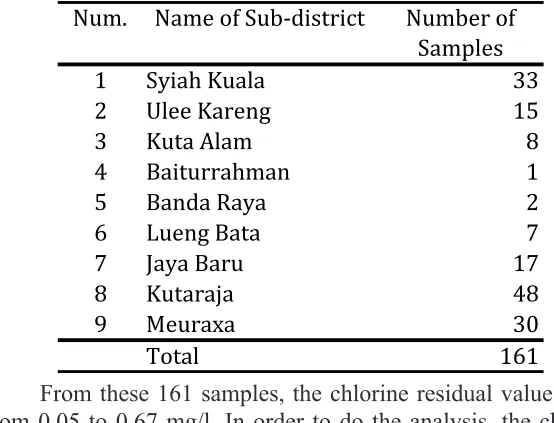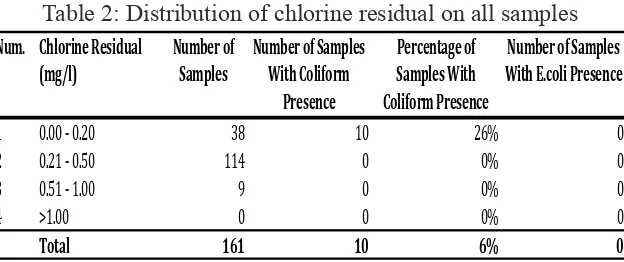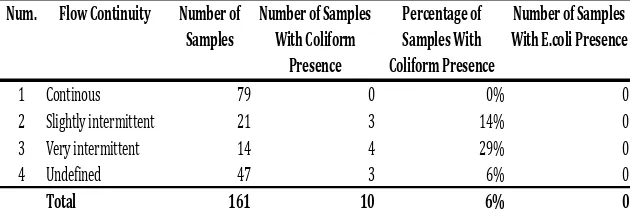Low Chlorine Residual and Intermittent Flow Lead to Coliforms Presence: A Study Case on Banda Aceh Water
Supply System
Fathul Mahdariza
Environmental Engineering Department, State Islamic University Ar-Raniry, Indonesia
Email: fathul.mahdariza@ar-raniry.ac.id
Abstract Even though the water is supplied from Water Treatment Plant 24 hours a day, some consumers of Tirta Daroy Water Supply Company receive water in their taps intermittently. This condition leads to several reported pipe breaks and coliforms presence, as well. Tirta Daroy conducts a quality control activity so called Pamkor on regular basis. This study is conducted to analyse data obtained from this activity during 2014, with the focus on the total coliforms for total 161 sampling connections. The result demonstrates that the coliforms presence is encouraged by the low chlorine residual and intermittent supply. Additional finding shows these two conditions occur mainly at the areas which have long distance to the water treatment plant.
Keywords Intermittent Flow, Coliforms, Chlorine Residual, Chlorination
Introduction
Tirta Daroy Water Supply Company (Indonesian: PDAM Tirta Daroy) is a municipal water supply company serving the area of Banda Aceh City. The raw water is extracted from Krueng Aceh River (SDC and PT NWC, 2007) which is situated approximately 8 km from the outside border of Banda Aceh City, and then processed at two Water Treatment Plants (WTPs), namely Lambaro and Siron, prior to the distribution.
water treatment effectiveness and the integrity of the distribution system (Cohn, et al., 1999).
United Nation Environment Programme (2006) deines coliforms bacteria as collection of relatively harmless micro-organisms living in large numbers in the intestines of man and warm- and cold-blooded animals. Based on Indonesian national regulations, the presence of both coliforms and E. coli is limited to zero on all samples (Menteri Kesehatan RI, 2010). This study is conducted to analyse data obtained from Pamkor activity during 2014, in term of total coliforms and E. coli presence for the total 161 samples.
Intermittent Flow Encourages Bacterial Growth
Lambaro WTP is designed to produce and supply water continuously 24 hours a day. Yet, most of consumers receive water intermittently. This condition is very common in developing countries. One of the main causes is due to low supply pressure (Ratnayaka, et al., 2009). The low pressure occurs especially in the area where is far from installation, as the consequence of head loss during transportation. In an intermittent supply situation, the consumers typically secure their water supply through the use of ground or roof tanks, which are illed during the time that the supply is provided (Charalambous, 2011). However, the majority of Tirta Daroy consumers prefer to install a house pump connected directly to the connection pipes, instead of ground tanks, in order to fulil their water demand. Consequently, it disturbs the low design, and lead to worsen the intermittent low for consumers without house pump installation.
detection mechanism is very dificult (Ratnayaka, et al., 2009). This condition also applies to Tirta Daroy, where some pipe breaks has been reported, especially in the areas which have long distance to WTP. Combined with the house pump installation, the unseen pipe breaks are nearly undetectable.
The Use of Chlorination as Disinfection
Total coliforms are commonly used to show the possible presence of microbial contamination from human waste in form of faecal contamination, which the major subset is E. coli (Cohn, et al., 1999; Pontius, et al., 2005). A comprehensive water quality monitoring program should be conducted throughout distribution systems for several parameters, including chlorine residual, bacteriological and physical measurements (Hesby, 2005). And if any of samples test positive for coliforms bacteria, a further test to detect E. coli presence should be conducted (Vacs Renwick, 2013).
Like most of water supply companies in developing country, Tirta Daroy uses chlorination as disinfecting process for bacterial growth in supplied water. Since chlorination has a lasting residual effect, is relatively easy to handle and cost effective, its use in drinking-water has been proven effectively for inactivation of microbial pathogens for nearly 100 years (World Health Organization, 2004; Gray, 2005). Most individuals are able to taste or smell chlorine odour in drinking-water at concentrations well below 5 mg/l, and some at levels as low as 0.3 mg/l (World Health Organization, 2011). But interestingly, in spite of its unpleasant odour, some individuals will assume the water is not safe to drink unless they smell chlorine odour (Dietrich, 2006). Regarding the health issue, there is no evidence that the levels of chlorine residual normally found in drinking water are harmful to health (Ratnayaka, et al., 2009). Tirta Daroy targets the chlorine residual at the end connection should be more than 0.2 mg/l in order to avoid the bacterial growth in the supplied water.
Pamkor 2014 Result and Analysis
and (2) technical data containing turbidity, conductivity, Total Dissolved Solid (TDS), salinity, temperature, pH, chlorine residual, total detected coliforms, total E. coli and remarks regarding supply continuity. This study uses data describing the sampled connection’s address, chlorine residual, total detected coliforms, total E. coli and supply continuity to do the analysis. The later data is obtained based on on-site interview to the connection owners.
The obtained samples during 2014 cover 40 out of 90 villages and all 9 sub-districts in Banda Aceh City. The sampling distribution on sub-districts (Table 1) shows a signiicant number of samples for Kutaraja, Syiah Kuala, Meuraxa, Ulee Kareng and Jaya Baru sub-districts, since these 5 sub-districts have distance to the treatment plants, hence, it is expected to have low chlorine residual due to loss during water transport. Therefore, the Pamkor activity took more samples on these sub-districts.
Table 1: Samples distribution on 9 sub-districts
Num. Name of Sub-district Number of
Samples
1 Syiah Kuala 33
2 Ulee Kareng 15
3 Kuta Alam 8
4 Baiturrahman 1
5 Banda Raya 2
6 Lueng Bata 7
7 Jaya Baru 17
8 Kutaraja 48
9 Meuraxa 30
Total 161
Table 2: Distribution of chlorine residual on all samples
Based on the data, number of samples with chlorine residual range of 0.00 – 0.20 mg/l contributes to 38 samples, 35 of which are located at the 5 sub-districts having long distance to the treatment plants. Combined with the tropical condition as the samples water temperature are ranged of 27° - 32°, the long distances transport leads to microbial growth, as deined by World Health Organization (2011). Table 2 also shows that 10 of totally 38 samples with chlorine residual range of 0.00 – 0.20 mg/l have coliforms, while none is detected at other chlorine residual ranges. It supports the approach of research by Vacs Renwick (2013), who assumed the water will be coliform free if the average chlorine residual is above 0.2 mg/l, although The World Health Organization recommended a safer approach of minimally 0.5 mg/l chlorine residual after at least 30 minutes contact time. The later minimum value is also applied when potential waterborne disease occurs or when faecal contamination of a drinking-water supply is detected (World Health Organization, 2011; Ratnayaka, et al., 2009). However, in this study, there is no detection of coliforms or E. coli in the samples with chlorine residual of 0.21 – 0.50 mg/l.
Table 3: Correlation between low continuity and coliform presence
Num. Flow Continuity Number of Samples
Number of Samples With Coliform
Presence
Percentage of Samples With Coliform Presence
Number of Samples With E.coli Presence
1 Continous 79 0 0% 0
2 Slightly intermittent 21 3 14% 0
3 Very intermittent 14 4 29% 0
4 Undefined 47 3 6% 0
Total 161 10 6% 0
The result shows that the samples with continuous low give zero result on the presence of coliforms and E. coli. The percentage of samples with coliform presence rises when the low continuity is slightly intermittent and very intermittent, respectively. Furthermore, there are 3 out of 47 samples with undeined low continuity having coliform presence. It is as expected, since the undeined low should contain the samples with intermittent low, beside the connections with continuous low. In conclusion, continuous low provides safest way to avoid bacterial presence in the supply system.
Conclusion
Based on overall results, the combination of chlorine residual and low continuity plays the most important role in coliforms presence. Should the chlorine residual is maintained above 0.2 mg/l and the supply is continuous, the supplied water is expected to have coliforms free. In addition, since the transport distance inluences the chlorine residual, an additional chlorine injection for the long distance connections can be considered. Since the area with long distance connections will also need additional booster pump in order to maintain minimum design pressure, the additional chlorination can be done at this booster pump installation.
Bibliography
Charalambous, Bambos. Water Supply Networks and Pipelines: The Hidden Costs of Resorting to Intermittent Supplies. IWA Water December 21, 2011. 2011.
Cohn, Perry D.; Cox, Michael; Berger, Paul S. Health and Aesthetic Aspects of Water Quality (In: Water Quality and Treatment: A Handbook of Community Water Supplies - 5th Edition. Editor: Letterman, Raymond D. New York: McGraw-Hill. 1999).
Gray, Nick F. Water Technology: An Introduction for Environmental Scientists and Engineers – 2nd Edition. Dublin: Elsevier Science & Technology Books. 2005.
Hesby, James C. Oxidation and Disinfection (In: Water Treatment Plant Design. Editor: Edward Baruth. New York: McGraw-Hill. 2005).
Menteri Kesehatan RI. Peraturan Menteri Kesehatan Republik Indonesia Nomor Nomor 492/MENKES/PER/IV/2010
tentang Persyaratan Kualitas Air Minum (Eng: Indonesian
Public Health Minister Decree Number 492/MENKES/ PER/IV/2010 about the Conditions of Drinking Water). Jakarta: Kementerian Kesehatan. 2010.
Nagari. 24-hour Water Supply: Is this Goal Achievable?. Hyderabad: Water and Sanitation Programme. 2003.
Standards, Regulation, and Goals (In: Water Quality and Treatment: A Handbook of Community Water Supplies - 5th Edition. Editor: Letterman, Raymond D. New York: McGraw-Hill. 2005).
Ratnayaka, Don D.; Brandt, Malcom J.;Johnson, Michael. Twort’s Water Supply – 6th Edition. Oxford: Elsevier. 2009.
SDC and PT NWC. Lambaro WTP Operation Manual. Banda Aceh. 2007.
United Nations Environment Programme. Water Quality for Ecosystem and Human Health. Ontario: United Nations Environment Programme Global Environment Monitoring System (GEMS). 2006.
World Health Organization. Guidelines for Drinking Water Quality – 4th Edition. Malta: Gutenberg. 2011.
World Health Organization. Water Treatment and Pathogen Control: Process Eficiency in Achieving Safe Drinking Water. Edited by Mark W LeChevallier and Kwok-Keung Au. London: IWA Publishing. 2004.


